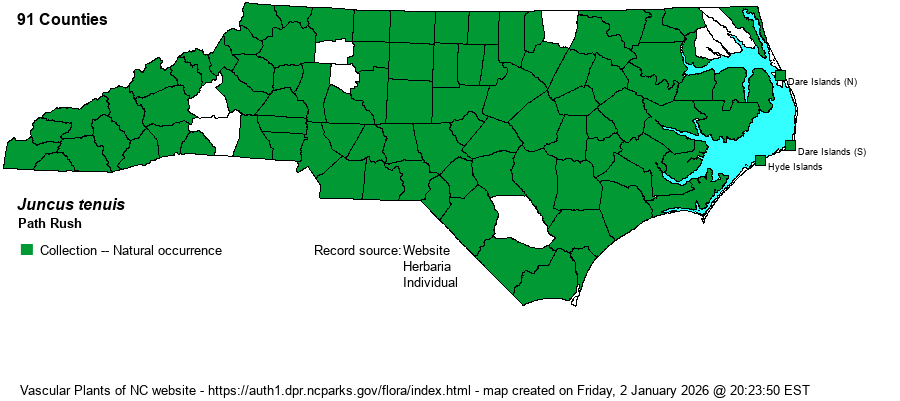| Author | Willdenow | |
| Distribution | Throughout the state; no doubt in every county.
Lab. to AK, south to FL, TX, and CA; Mex., C.A., S.A. | |
| Abundance | Commonly encountered. Can be abundant along trails and woods roads. | |
| Habitat | Well-named, this species survives well in well-trodden paths, trails, woods roads, dirt driveways, edges of parking lots, and other disturbed places. Where heavily trodden, stems are rather short and +- parallel to ground. It also inhabits fields and open floodplain meadows, where plants grow taller and straight. |
| Phenology | Flowering and fruiting June-September. | |
| Identification | Path Rush is a plant that everyone has seen, whether they know it or not. Plants typically grow several or many stems together, a foot tall or less (to 2 feet where not trampled), the stems wiry, and flowers arranged singly on short branches. A key feature is the auricle at the mouth of the leaf sheath, which is pale and extends well past the mouth (vs. short and blunt in J. dichotomus, georgianus, secundus). | |
| Taxonomic Comments | NOTE on Juncus: These "grasslike" or "sedgelike" plants occur in most habitats, especially where moist or wet. They can immediately be told from grasses and sedges by the presence of 6 tepals (petal-like) that surround the fruit. These tepals can be thought of as analogous to sepals and petals of, say, lilies or trilliums. Most species have brown, chestnut, or reddish tepals and dark brown fruits. The flowers occur in few- to many-flowered heads. Leaves are nearly all basal and round in cross-section. Stems are unbranched, except for the inflorescence. Fruits are termed capsules and contain many tiny seeds. | |
| Other Common Name(s) | | |
| State Rank | S5 | |
| Global Rank | G5 | |
| State Status | | |
| US Status | | |
| USACE-agcp | FAC link |
| USACE-emp | FAC link |

